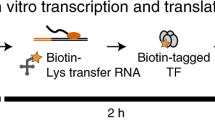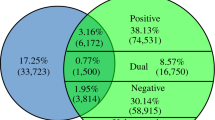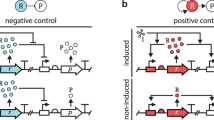Abstract
Evolution of gene regulation is an important contributor to the variety of life. Here, we analyse the evolution of a combinatorial transcriptional circuit composed of sequence-specific DNA-binding proteins that are conserved among all eukaryotes. This circuit regulates mating in the ascomycete yeast lineage. We first identify a group of mating genes that was transcriptionally regulated by an activator in a fungal ancestor, but is now transcriptionally regulated by a repressor in modern bakers' yeast. Despite this change in regulatory mechanism, the logical output of the overall circuit remains the same. By examining the regulation of mating in modern yeasts that are related to different extents, we deduce specific, sequential changes in both cis- and trans-regulatory elements that constitute the transition from positive to negative regulation. These changes indicate specific mechanisms by which fitness barriers were traversed during the transition.
This is a preview of subscription content, access via your institution
Access options
Subscribe to this journal
Receive 51 print issues and online access
$199.00 per year
only $3.90 per issue
Buy this article
- Purchase on Springer Link
- Instant access to full article PDF
Prices may be subject to local taxes which are calculated during checkout






Similar content being viewed by others
References
Darwin, C. R. The Origin of Species (Gramercy, New York, 1859)
Carroll, S. B., Grenier, J. K. & Weatherbee, S. D. From DNA to Diversity (Blackwell Science, Malden, Massachusetts, 2001)
Davidson, E. H. Genomic Regulatory Systems (Academic, San Diego, California, 2001)
Gerhart, J. & Kirschner, M. Cells, Embryos, and Evolution (Blackwell Science, Malden, Massachusetts, 1997)
Levine, M. & Tjian, R. Transcription regulation and animal diversity. Nature 424, 147–151 (2003)
Doebley, J. & Lukens, L. Transcriptional regulators and the evolution of plant form. Plant Cell 10, 1075–1082 (1998)
Gompel, N., Prud'homme, B., Wittkopp, P. J., Kassner, V. A. & Carroll, S. B. Chance caught on the wing: cis-regulatory evolution and the origin of pigment patterns in Drosophila. Nature 433, 481–487 (2005)
Ihmels, J. et al. Rewiring of the yeast transcriptional network through the evolution of motif usage. Science 309, 938–940 (2005)
Ludwig, M. Z., Patel, N. H. & Kreitman, M. Functional analysis of eve stripe 2 enhancer evolution in Drosophila: rules governing conservation and change. Development 125, 949–958 (1998)
Ronshaugen, M., McGinnis, N. & McGinnis, W. Hox protein mutation and macroevolution of the insect body plan. Nature 415, 914–917 (2002)
Tanay, A., Regev, A. & Shamir, R. Conservation and evolvability in regulatory networks: the evolution of ribosomal regulation in yeast. Proc. Natl Acad. Sci. USA 102, 7203–7208 (2005)
Wittkopp, P. J., Haerum, B. K. & Clark, A. G. Evolutionary changes in cis and trans gene regulation. Nature 430, 85–88 (2004)
Galant, R. & Carroll, S. B. Evolution of a transcriptional repression domain in an insect Hox protein. Nature 415, 910–913 (2002)
Hull, C. M., Raisner, R. M. & Johnson, A. D. Evidence for mating of the “asexual” yeast Candida albicans in a mammalian host. Science 289, 307–310 (2000)
Herskowitz, I., Rine, J. & Strathern, J. Mating-type determination and Mating-type interconversion in Saccharomyces cerevisiae (eds Jones, E. W., Pringle, J. R. & Broach, J. R.) 583–656 (Cold Spring Harbor Laboratory Press, Cold Spring Harbor, 1992)
Tsong, A. E., Miller, M. G., Raisner, R. M. & Johnson, A. D. Evolution of a combinatorial transcriptional circuit: a case study in yeasts. Cell 115, 389–399 (2003)
Staben, C. & Yanofsky, C. Neurospora crassa a mating-type region. Proc. Natl Acad. Sci. USA 87, 4917–4921 (1990)
Kelly, M., Burke, J., Smith, M., Klar, A. & Beach, D. Four mating-type genes control sexual differentiation in the fission yeast. EMBO J. 7, 1537–1547 (1988)
Kurischko, C., Schilhabel, M. B., Kunze, I. & Franzl, E. The MATA locus of the dimorphic yeast Yarrowia lipolytica consists of two divergently oriented genes. Mol. Gen. Genet. 262, 180–188 (1999)
Philley, M. L. & Staben, C. Functional analyses of the Neurospora crassa MT a-1 mating type polypeptide. Genetics 137, 715–722 (1994)
Turgeon, B. G. et al. Cloning and analysis of the mating type genes from Cochliobolus heterostrophus. Mol. Gen. Genet. 238, 270–284 (1993)
Butler, G. et al. Evolution of the MAT locus and its Ho endonuclease in yeast species. Proc. Natl Acad. Sci. USA 101, 1632–1637 (2004)
Calderone, R. A. Candida and Candidiasis (ed. Calderone, R. A.) (ASM, Washington DC, 2002)
Hedges, S. B. The origin and evolution of model organisms. Nature Rev. Genet. 3, 838–849 (2002)
Bender, A. & Sprague, G. F. Jr. Yeast peptide pheromones, a-factor and α-factor, activate a common response mechanism in their target cells. Cell 47, 929–937 (1986)
Bennett, R. J., Uhl, M. A., Miller, M. G. & Johnson, A. D. Identification and characterization of a Candida albicans mating pheromone. Mol. Cell. Biol. 23, 8189–8201 (2003)
Bailey, T. L. & Elkan, C. Fitting a mixture model by expectation maximization to discover motifs in biopolymers. Proc. Int. Conf. Intell. Syst. Mol. Biol. 2, 28–36 (1994)
Acton, T. B., Mead, J., Steiner, A. M. & Vershon, A. K. Scanning mutagenesis of Mcm1: residues required for DNA binding, DNA bending, and transcriptional activation by a MADS-box protein. Mol. Cell. Biol. 20, 1–11 (2000)
Tan, S. & Richmond, T. J. Crystal structure of the yeast MATalpha2/MCM1/DNA ternary complex. Nature 391, 660–666 (1998)
Kjaerulff, S., Dooijes, D., Clevers, H. & Nielsen, O. Cell differentiation by interaction of two HMG-box proteins: Mat1-Mc activates M cell-specific genes in S. pombe by recruiting the ubiquitous transcription factor Ste11 to weak binding sites. EMBO J. 16, 4021–4033 (1997)
Smith, D. L. & Johnson, A. D. A molecular mechanism for combinatorial control in yeast: MCM1 protein sets the spacing and orientation of the homeodomains of an α2 dimer. Cell 68, 133–142 (1992)
van Beest, M. et al. Sequence-specific high mobility group box factors recognize 10–12-base pair minor groove motifs. J. Biol. Chem. 275, 27266–27273 (2000)
Care, R. S., Trevethick, J., Binley, K. M. & Sudbery, P. E. The MET3 promoter: a new tool for Candida albicans molecular genetics. Mol. Microbiol. 34, 792–798 (1999)
Rokas, A., Williams, B. L., King, N. & Carroll, S. B. Genome-scale approaches to resolving incongruence in molecular phylogenies. Nature 425, 798–804 (2003)
Byrne, K. P. & Wolfe, K. H. The Yeast Gene Order Browser: combining curated homology and syntenic context reveals gene fate in polyploid species. Genome Res. 15, 1456–1461 (2005)
Cliften, P. et al. Finding functional features in Saccharomyces genomes by phylogenetic footprinting. Science 301, 71–76 (2003)
Belloch, C., Querol, A., Garcia, M. D. & Barrio, E. Phylogeny of the genus Kluyveromyces inferred from the mitochondrial cytochrome-c oxidase II gene. Int. J. Syst. Evol. Microbiol. 50, 405–416 (2000)
Wong, S., Butler, G. & Wolfe, K. H. Gene order evolution and paleopolyploidy in hemiascomycete yeasts. Proc. Natl Acad. Sci. USA 99, 9272–9277 (2002)
Mead, J., Zhong, H., Acton, T. B. & Vershon, A. K. The yeast α2 and Mcm1 proteins interact through a region similar to a motif found in homeodomain proteins of higher eukaryotes. Mol. Cell. Biol. 16, 2135–2143 (1996)
Jacobson, M. P. & Friesner, R. A. Protein local optimization program. http://francisco.compbio.ucsf.edu/~jacobson/plop_manual/plop_overview.htm (2006).
Lengeler, K. B. et al. Signal transduction cascades regulating fungal development and virulence. Microbiol. Mol. Biol. Rev. 64, 746–785 (2000)
Acton, T. B., Zhong, H. & Vershon, A. K. DNA-binding specificity of Mcm1: operator mutations that alter DNA-bending and transcriptional activities by a MADS box protein. Mol. Cell. Biol. 17, 1881–1889 (1997)
Kellis, M., Birren, B. W. & Lander, E. S. Proof and evolutionary analysis of ancient genome duplication in the yeast Saccharomyces cerevisiae. Nature 428, 617–624 (2004)
Wolfe, K. H. & Shields, D. C. Molecular evidence for an ancient duplication of the entire yeast genome. Nature 387, 708–713 (1997)
Higgins, D. G. & Sharp, P. M. CLUSTAL: a package for performing multiple sequence alignment on a microcomputer. Gene 73, 237–244 (1988)
Schmidt, H. A., Strimmer, K., Vingron, M. & von Haeseler, A. TREE-PUZZLE: maximum likelihood phylogenetic analysis using quartets and parallel computing. Bioinformatics 18, 502–504 (2002)
Debuchy, R., Arnaise, S. & Lecellier, G. The mat- allele of Podospora anserina contains three regulatory genes required for the development of fertilized female organs. Mol. Gen. Genet. 241, 667–673 (1993)
Acknowledgements
We are grateful to M. Jacobson for advice provided in modelling the K. lactis α2 and Mcm1 structures. We also thank S. Ästrøm for providing unpublished K. lactis strains and advice on their handling, P. Sudbury for providing the GFP reporter construct, M. Lorentz and G. Fink for the collaboration that produced the DNA microarrays used in this paper, and the Broad Institute (http://www.broad.mit.edu/annotation/fungi/fgi/), the Sanger Center (http://www.sanger.ac.uk/Projects/Fungi/), and the Pathogen Sequencing Unit at the Wellcome Trust Sanger Institute (http://www.sanger.ac.uk/sequencing/Candida/dubliniensis/) for making sequence data available. M. Ptashne provided valuable comments on the manuscript. We thank B. Hromatka for overseeing microarray printing, and R. Bennett for microarray data and discussions. R. Zordan, A. Uhl, M. Lohse, M. Miller, R. Wu, C. Chaivorapol and other members of the Johnson and Li labs provided useful discussions. This work was supported by grants from the NIH to A.D.J. A.E.T was supported by a Howard Hughes Medical Institute Predoctoral Fellowship. B.B.T. is an NSF Predoctoral Fellow. B.B.T. and H.L. acknowledge partial support from a Packard Fellowship in Science and Engineering (to H.L.) and an NIH grant. Author Contributions A.E.T. determined the asgs of C. albicans, and validated the asg operator site. B.T. constructed the phylogenetic tree, analysed asg operators across multiple species, and modelled the K. lactis α2–Mcm1 interaction. H.L. and A.D.J. oversaw the work.
Author information
Authors and Affiliations
Corresponding author
Ethics declarations
Competing interests
Microarray data are available in Supplementary Information and at http://genome.ucsf.edu/asg_evolution/. Reprints and permissions information is available at www.nature.com/reprints. The authors declare no competing financial interests.
Supplementary information
Supplementary Notes
This file contains Supplementary Methods, Supplementary Figure Legends and Supplementary Tables (Position weight matrices for C. albicans and S. cerevisiae asg operators). (DOC 118 kb)
Supplementary Figure 1
Strategy used to identify asgs in C. albicans. (PDF 21 kb)
Supplementary Figure 2
Clustering analysis of putative asg operators (JPG 105 kb)
Supplementary Data
Microarray data used to identify the asgs in C. albicans (DOC 23 kb)
Rights and permissions
About this article
Cite this article
Tsong, A., Tuch, B., Li, H. et al. Evolution of alternative transcriptional circuits with identical logic. Nature 443, 415–420 (2006). https://doi.org/10.1038/nature05099
Received:
Accepted:
Issue Date:
DOI: https://doi.org/10.1038/nature05099
This article is cited by
-
Robustness and innovation in synthetic genotype networks
Nature Communications (2023)
-
The causes of evolvability and their evolution
Nature Reviews Genetics (2019)
-
Prokaryotic horizontal gene transfer within the human holobiont: ecological-evolutionary inferences, implications and possibilities
Microbiome (2018)
-
Tribotronic triggers and sequential logic circuits
Nano Research (2017)
-
Evolution of transcriptional networks in yeast: alternative teams of transcriptional factors for different species
BMC Genomics (2016)
Comments
By submitting a comment you agree to abide by our Terms and Community Guidelines. If you find something abusive or that does not comply with our terms or guidelines please flag it as inappropriate.



